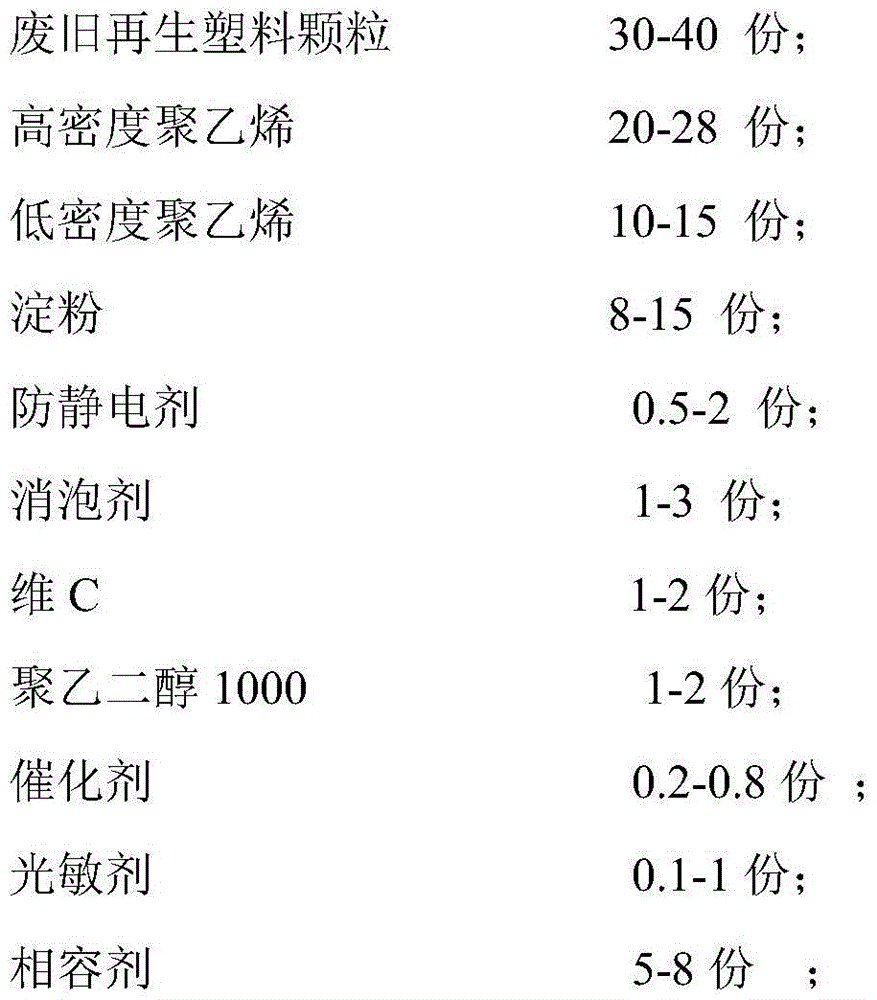Production method of degradable plastic woven bag
A technology for degrading plastics and woven bags, applied in the field of plastics, can solve problems such as the decrease of tensile strength and elongation at break, and achieve the effects of reducing pollution, excellent antistatic performance, and good degradation performance.
- Summary
- Abstract
- Description
- Claims
- Application Information
AI Technical Summary
Problems solved by technology
Method used
Image
Examples
Embodiment 1
[0019] 1) Mix 30 parts of waste recycled plastic granules, 28 parts of high-density polyethylene, 15 parts of low-density polyethylene, 10 parts of starch, 1 part of antistatic agent, 2 parts of defoaming agent, 1 part of vitamin C-1, polyethylene glycol 1000-2 parts, 0.3 parts of catalyst, 0.5 parts of photosensitizer, and 6 parts of compatibilizer were put into a high-speed mixer and mixed evenly, and then dried at 90°C for 25 minutes;
[0020] 2) Feed the dried mixture into a twin-screw extruder, extrude hollow microtubes one by one through an extruder head with multiple annular channels, and control the traction ratio to 1:5, after preliminary cooling by water Then it is pulled by the oven to control the draft ratio to 5, and then after heat setting, it shrinks at a low traction speed and controls the retraction ratio to 0.97. Finally, it is wound by the cam combined energy-saving winding machine and sent to the circular loom for further processing. weave.
[0021] 3) The...
Embodiment 2
[0023] 1) Mix 35 parts of waste recycled plastic granules, 24 parts of high-density polyethylene, 12 parts of low-density polyethylene, 10 parts of starch, 1 part of antistatic agent, 2 parts of defoaming agent, 1 part of vitamin C-1, polyethylene glycol 1000-2 parts, 0.4 parts of catalyst, 0.5 parts of photosensitizer, and 6 parts of compatibilizer were respectively put into a high-speed mixer and mixed evenly, and then dried at 90°C for 25 minutes;
[0024] 2) Feed the dried mixture into a twin-screw extruder, extrude hollow microtubes one by one through an extruder head with multiple annular channels, and control the traction ratio to 1:5, after preliminary cooling by water Then it is pulled by the oven to control the draft ratio to 5, and then after heat setting, it shrinks at a low traction speed and controls the retraction ratio to 0.97. Finally, it is wound by the cam combined energy-saving winding machine and sent to the circular loom for further processing. weave.
...
Embodiment 3
[0027] 1) Mix 40 parts of waste recycled plastic granules, 20 parts of high-density polyethylene, 10 parts of low-density polyethylene, 10 parts of starch, 1 part of antistatic agent, 2 parts of defoaming agent, 1 part of vitamin C-, polyethylene glycol 1000-2 parts, 0.5 parts of catalyst, 0.5 parts of photosensitizer, and 6 parts of compatibilizer were put into a high-speed mixer and mixed evenly, and then dried at 90°C for 25 minutes;
[0028] 2) Feed the dried mixture into a twin-screw extruder, extrude hollow microtubes one by one through an extruder head with multiple annular channels, and control the traction ratio to 1:5, after preliminary cooling by water Then it is pulled by the oven to control the draft ratio to 5, and then after heat setting, it shrinks at a low traction speed and controls the retraction ratio to 0.97. Finally, it is wound by the cam combined energy-saving winding machine and sent to the circular loom for further processing. weave.
[0029] 3) The ...
PUM
 Login to View More
Login to View More Abstract
Description
Claims
Application Information
 Login to View More
Login to View More - R&D
- Intellectual Property
- Life Sciences
- Materials
- Tech Scout
- Unparalleled Data Quality
- Higher Quality Content
- 60% Fewer Hallucinations
Browse by: Latest US Patents, China's latest patents, Technical Efficacy Thesaurus, Application Domain, Technology Topic, Popular Technical Reports.
© 2025 PatSnap. All rights reserved.Legal|Privacy policy|Modern Slavery Act Transparency Statement|Sitemap|About US| Contact US: help@patsnap.com


